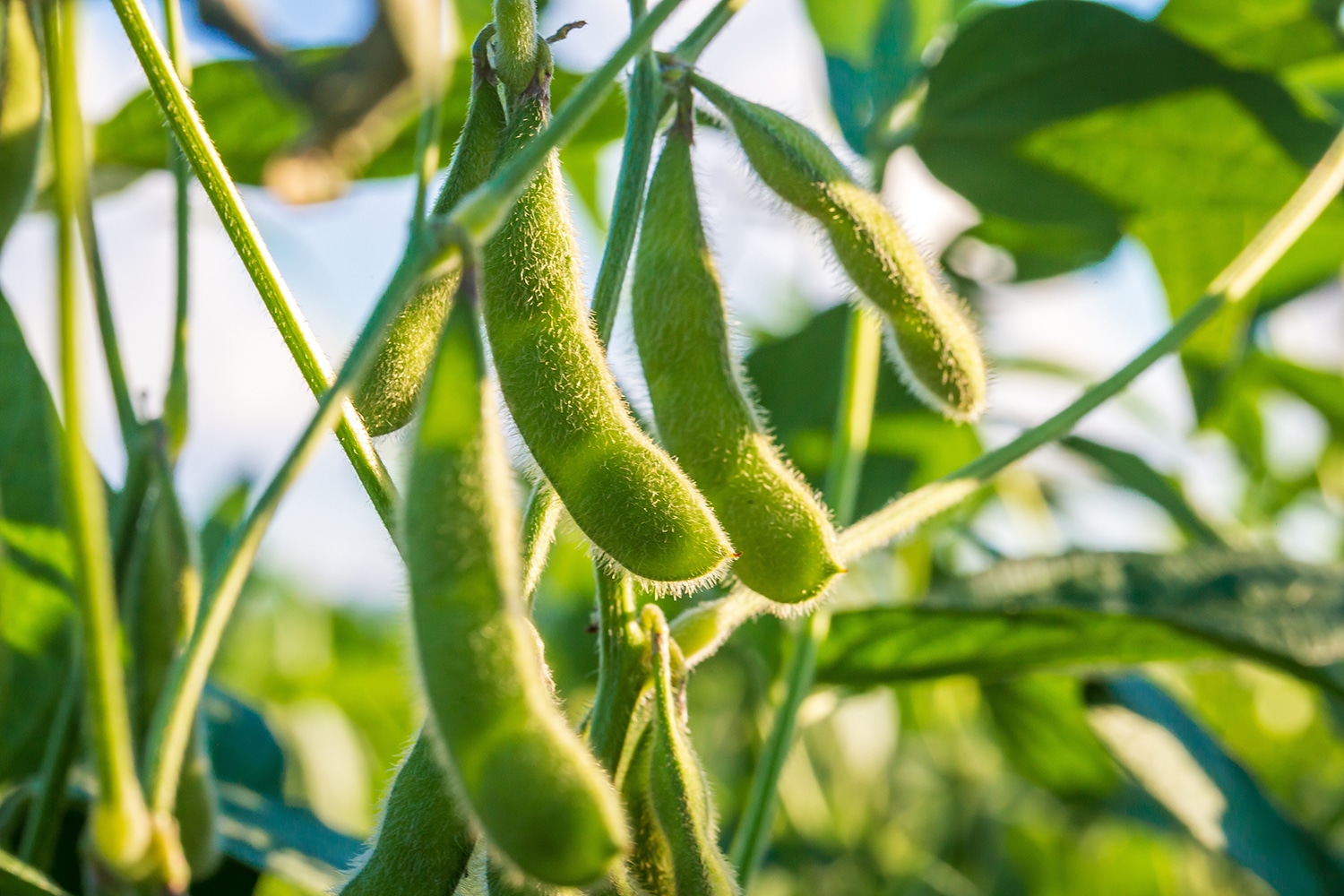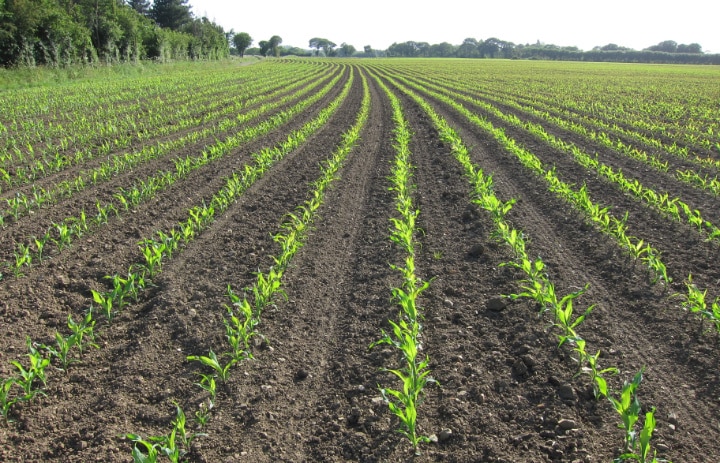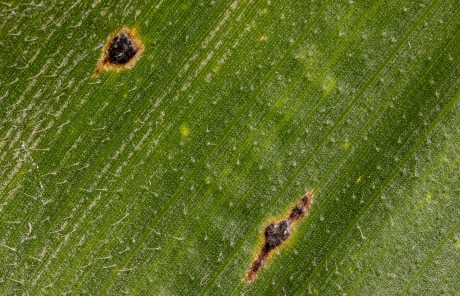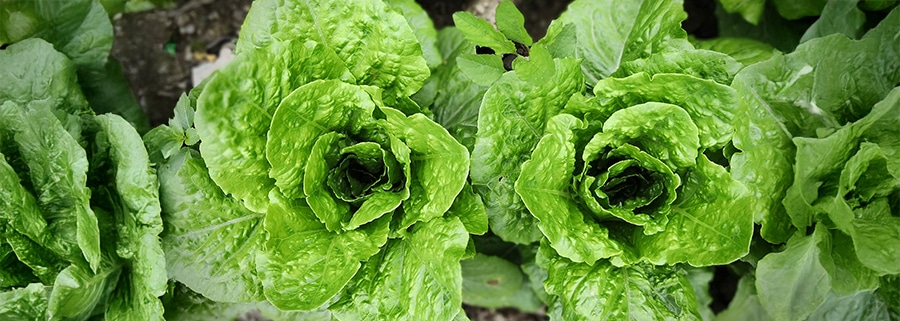Why improving soil health is important for long-term benefits
Beneath our feet lies one of the most powerful forces of nature: soil. Far from being inert, it’s a living, breathing system teeming with life and energy, quietly working to sustain the crops that feed us and the ecosystems that nurture our world. Healthy soil is the foundation for clean air, clean water, and productive farmland, making it indispensable to agriculture’s success and the planet’s balance. Like the roots of a tree, its unseen work is critical—filtering water, cycling nutrients, and anchoring plants to grow and thrive.
For growers, healthy soil is both a resource and an opportunity. Investing in soil health creates the conditions for consistent, profitable harvests. Soil acts as a natural filter, removing outside substances, improving water retention, and reducing harmful runoff while keeping nutrients where they’re needed. Rich organic matter further strengthens root systems, helping crops resist drought and absorb nutrients more effectively. Its resilience directly translates into reduced risk and increased reliability for growers managing unpredictable seasons.
The rewards of healthy soil are measurable. A recent nationwide study demonstrated that adopting soil health practices significantly reduced input costs while increasing yields. When soil is functioning at its peak, reliance on synthetic inputs decreases, creating a win-win for profitability and sustainability.
Harnessing these benefits starts with implementing strategies that enhance soil’s biological, physical, and chemical properties. The best ways to improve soil health go beyond surface-level fixes to strengthen the foundation of your soil ecosystem.
Maximize living roots
Keeping roots in the soil year-round (through practices like crop rotation and double cropping) feeds beneficial microbes, stabilizes soil, and improves soil structure. It creates a thriving soil ecosystem that can handle the demands of intensive growing.
Minimize disturbance
Reduced tillage or no-till farming preserves soil structure and organic matter, preventing erosion and supporting microbial communities. By leaving the soil undisturbed, growers can naturally build fertility while reducing inputs.
Maximize cover
Cover crops act as natural shields, protecting soil from erosion and suppressing weeds. Nitrogen-fixing cover crops such as legumes enrich the soil naturally, improving fertility and productivity for the following crop. Creating a mix with grass species helps to increase soil aggregation and water holding capacity.
Enhance biodiversity
Diversifying crop rotations and incorporating compost or carbon-based fertilizers promote a strong soil food web that improves nutrient cycling and builds resistance to disease.
By adopting these practices, you’ll build a healthier, more productive soil ecosystem that supports this season’s crops and sets the stage for sustainable, long-term growth.
The next step? Keep reading for ways to prime your soil in the spring to unlock its full potential.
3 ways to improve soil health by priming your soil in the spring
Spring is the ideal time to breathe life into your soil and prepare it for a productive growing season. Priming your soil early allows it to transition from being simply ready to plant into a high-functioning system capable of maximizing crop performance. Growers can increase nutrient cycling, foster healthier root systems, and achieve better fertilizer efficiency with properly prepared soil.
1. Improve fertilizer use efficiency
Fertilizer is one of the most significant investments a grower makes, but its effectiveness hinges on the soil’s ability to retain and deliver nutrients. Without the right conditions, even the best fertilizers can fall short. That’s why focusing on soil quality early in the growing season is so critical for success. That focus means that crops can thrive and make every fertilizer dollar count.
Priming the soil will help create a thriving ecosystem filled with active beneficial microbes such as beneficial fungi and bacteria. The organisms work to break down organic matter into plant-available nutrients by keeping them locked in the soil where they’re needed. It helps reduce losses to leaching or runoff and ensures nutrients are readily accessible during critical growth stages.
Expanding on these efforts, tools like biostimulants and compost amplify the benefits of soil priming. As soil improves, they enrich the soil with nutrients while also enhancing its structure and functionality to address challenges like nutrient retention and soil drainage. Growers can use these tools to create the ideal conditions for crop growth while improving long-term soil health.
For those focused on phosphorus, a key nutrient for energy transfer and root development, spring is the perfect time to act. Phosphorus drives higher yields, stronger roots, and earlier crop maturity, but it often binds in the soil, making it inaccessible to plants. Biological soil priming unlocks this nutrient, enhancing fertilizer efficiency and reducing the need for synthetic inputs.
2. Promote healthier root systems
A strong root system is the foundation of a healthy crop. Healthy roots anchor plants, facilitate water and nutrient absorption, and boost resilience against drought, disease, and pests. When priming your soil, you’re preparing it for planting and creating the ideal conditions for strong root development.
Spring soil preparation often begins with addressing structural issues, such as mitgating compaction layers or enhancing drainage. Compacted or poorly drained soils hinder root development and nutrient uptake, but adding organic-based amendments like compost, seafood hydrolysates, or manure can loosen the soil and improve their functionality.
Further supporting this process, priming soil encourages the growth of beneficial fungi such as mycorrhizae, which form symbiotic relationships with plant roots. These fungi expand the root system’s access to water and nutrients, enhancing plant health and yield potential. For growers aiming to improve soil for vegetables, this approach ensures crops are set up for vigorous and sustained growth.
3. Boost nutrient availability
Nutrients like nitrogen, phosphorus, and potassium are essential for crop development, but they often become locked in the soil or depleted by previous harvests. Priming soil in the spring prioritizes the release of these nutrients so they’re available when crops need them most.
One of the most common questions growers face is how to improve bad soil or soil that has been overworked. Priming soil with carbon-based fertilizers, compost, or bio-based products activates microbial processes that break down organic matter and release nutrients. As mentioned, phosphorus is an example of a nutrient that is often unavailable early in the season due to soil-binding. Biological priming helps free phosphorus and other nutrients trapped in the soil matrix.
Adjusting soil pH is another effective way to boost nutrient availability. For growers needing to adjust soil pH, incorporating lime to reduce acidity or sulfur to address alkalinity ensures the soil’s environment is balanced for nutrient uptake. Balanced pH levels make all the difference when trying to prepare soil for planting, particularly for crops with specific pH preferences.
Finally, nutrient availability also requires correct timing. Priming ensures nutrients are accessible precisely when plants need them, reducing the risk of deficiencies during critical growth stages. This approach improves soil quality and allows for higher yields and healthier crops.
Experience full soil system benefits
Priming your soil begins in the root zone, where water and nutrient flow are critical for crop performance. Beneficial fungi, like mycorrhizae, play a vital role by extending plant root systems, allowing them to absorb water and nutrients more efficiently. Enhanced root reach is especially important in soils with limited drainage or compaction, as it allows plants to access vital resources even in challenging conditions. A thriving root zone is the start of a resilient and productive crop.
While the root zone delivers resources, many essential nutrients remain locked within the soil, inaccessible to plants. Priming addresses this by activating beneficial biological processes that release these trapped nutrients. Tidal Grow® Oceanic® accelerates biological activity, ensuring nutrients are mineralized and available when plants need them. Oceanic has a Soil Functionality Score of 8.93*—eight times higher than competing products—which highlights its ability to unlock nutrients effectively and outperform competing fish fertilizers.
Once nutrients are available, plant metabolism becomes the next critical factor for growth and resilience. Strong metabolic function depends on nutrients like calcium and nitrogen, which directly impact plant structure and energy production. Soluble calcium strengthens cell walls, giving plants the ability to resist pests, diseases, and environmental stresses. Meanwhile, nitrogen in the form of amino acids fuels essential processes like photosynthesis and protein synthesis, which provide immediate energy to plants during peak growth stages.
Together, these benefits create a soil system that supports plants and actively drives their success. You can count on better crop health, higher yields, and a more sustainable growing season by priming your soil for these interconnected improvements.
*(2023). Oceanic received a Soil Functionality Score 8x higher than competing fish fertilizers. Biome Makers DNA Sequencing.
Improve soil health with Oceanic
Oceanic is a cold-processed seafood hydrolysate liquid fertilizer designed to revolutionize soil health and crop performance. By delivering nutrients derived from bioactive amino acids, Oceanic works in harmony with the soil ecosystem to enhance its biological activity and provide essential resources for plant growth. Unlike traditional fertilizers, Oceanic improves the soil’s natural ability to support crops while fostering long-term sustainability.
Build soil health
Oceanic increases microbial biodiversity and community activity within the soil. Fostering a thriving soil ecosystem strengthens the biological foundation required for nutrient cycling and plant resilience. The microbial boost allows the soil to remain healthy and productive for future growing seasons.
Improve nutrient uptake
The bioactive amino acids in Oceanic are readily available to plants, making it easier for crops to absorb nutrients. Efficient nutrient delivery reduces waste so that plants receive the support they need for optimal growth and results (healthier yields).
Promote beneficial fungi growth
The seafood omega fats in Oceanic provide a critical energy source for beneficial fungi like mycorrhizae. Because cold spring soils have limited soil factors due to waterlogging and temperature, the persistence and success of these beneficial fungi are key for mobilizing nutrients. A spring primer like Oceanic promotes beneficial fungi growth, which in turn enhances nutrient availability, promotes root development, and protects plants by outcompeting soil-borne pathogens.
Improve soil quality with SeaPhos
Tidal Grow® SeaPhos® is a cold-processed seafood hydrolysate liquid fertilizer formulated to deliver bioavailable phosphorus. Derived from fish protein hydrolysate, micronized fish bone, and crab shell, SeaPhos offers a natural and efficient solution to optimize phosphorus levels in the soil while improving overall soil health. Its formula works in harmony with the soil ecosystem so nutrients are made readily accessible to crops at critical growth stages.
Phosphorus is vital for energy transfer, root development, and flowering, yet it often becomes locked in the soil and unavailable to plants. SeaPhos tackles this challenge by providing a sustained release of phosphorus, giving plants continuous access to this key nutrient. Allowing plants to unlock and efficiently utilize phosphorus makes SeaPhos an invaluable tool for growers looking to maximize yields while improving soil functionality.
Deliver sustained forms of phosphorus
SeaPhos provides a reliable source of phosphorus derived from fish bone to deliver maximum phosphorus efficiency. Unlike traditional fertilizers that may release nutrients too quickly, SeaPhos delivers phosphorus gradually, giving plants consistent access throughout the growing season. The sustained release supports healthy root development and plant growth.
Accelerate nutrient cycling
By promoting the activity and diversity of beneficial microbes, SeaPhos speeds up the breakdown of organic matter and the release of key nutrients trapped in the soil. Nutrient cycling improves phosphorus availability while further enhancing the overall fertility of the soil.
Promote beneficial fungi growth
Similar to Oceanic, SeaPhos includes seafood omega fats that serve as an energy source for beneficial fungi like mycorrhizae. Beneficial fungi growth with SeaPhos, similar to what we see with Oceanic, boosts nutrient availability, encourages root development, and safeguards plants by outcompeting soil-borne pathogens.
Differences between Oceanic and SeaPhos in improving soil quality
While both Oceanic and SeaPhos are innovative cold-processed seafood hydrolysate fertilizers designed to improve soil health, each product is tailored to address distinct needs in the soil ecosystem. Understanding these differences allows growers to make informed decisions about how to incorporate these powerful tools into their soil management strategy.
NPK values: a formula for targeted support
The primary distinction between Oceanic and SeaPhos lies in their nutrient profiles, as reflected in their respective NPK values (Nitrogen-Phosphorus-Potassium).
- Oceanic (2-1-0.3):
- Water-Soluble Nitrogen: 1.6%
- Available Phosphate (P2O5): 1%
- Potash: 0.3%
- SeaPhos (1.7-7-0):
- Water-Soluble Nitrogen: 1.3%
- Available Phosphate (P2O5): 7%
- No Potash
How to prime and add nutrients to your soil in the spring
Incorporating Oceanic and SeaPhos into your spring priming routine starts with understanding your soil’s specific needs. Testing your soil is a crucial first step, as it provides insight into nutrient levels, pH balance, and overall soil quality. This knowledge allows you to tailor your approach and ensure the best results for your crops.
Application rates & recommendations
Once your soil’s requirements are identified, you can determine the optimal timing for Oceanic or SeaPhos applications.
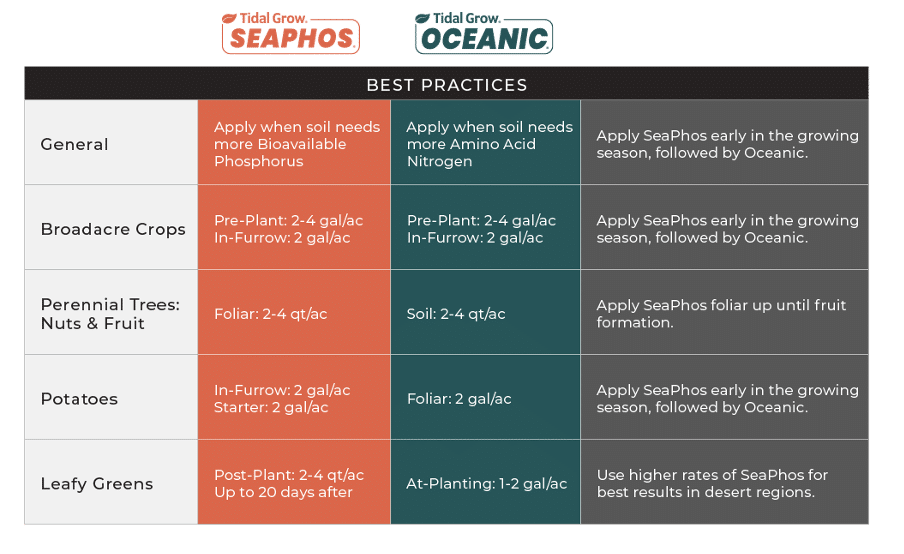
- These products are most effective when used strategically, aligning with the growth stages of your crops. For instance, SeaPhos is particularly useful early in the growing season when soils require more bioavailable phosphorus, while Oceanic excels in providing amino acid nitrogen to boost soil functionality.
- While Oceanic integrates seamlessly with traditional fertilizers, SeaPhos should not be mixed with mineral fertilizers. To avoid any issues, it’s always recommended to perform a jar test before combining these products with others.
Additionally, both Oceanic and SeaPhos are designed for versatility and ease of use. They work effectively in fertigation systems and foliar application methods and are screened to 150 mesh (105 microns) to ensure trouble-free spraying and drip application. Whether your focus is broadacre crops, perennial fruit and nut crops, or leafy greens, they offer tailored solutions for your soil’s specific needs.
Lastly, it’s important to note that while the recommended application timings ensure precision, they’re not one-size-fits-all. Some soils may require adjustments depending on their composition and the specific crop being grown. Both conventional and organic formulations are available, providing flexibility for growers looking to achieve healthier, more productive soil systems.
By integrating these complementary products into your spring soil management strategy, you can create a thriving, high-functioning soil ecosystem. With targeted support from Oceanic and SeaPhos, your soil will be primed to deliver a productive and profitable growing season.
Prime your soil in for spring planting
Priming your soil in the spring with Oceanic and/or SeaPhos is a strategic, seasonal investment in soil health and crop productivity. With the unique strengths of these products and how they complement each other, growers can improve nutrient cycling, enhance root health, and boost soil functionality. The result is a thriving, resilient soil ecosystem that supports higher yields and sustainable growing practices.
Key takeaways
- Oceanic enhances microbial biodiversity, improves nutrient uptake, and promotes beneficial fungi growth to strengthen soil health.
- SeaPhos delivers bioavailable phosphorus, accelerates nutrient cycling, and supports root systems with sustained nutrient release.
- Spring priming and testing your soil to apply the right product at the right time ensure your crops have the resources they need to thrive.
- Achieve better soil functionality by combining Oceanic and SeaPhos to unlock the full potential of your soil and create a foundation for long-term success.
Reach out to a Tidal Grow® AgriScience representative to discover how Oceanic and SeaPhos can help you maximize the health and productivity of your soil today—and for years to come.
Citations
(2017, September 1). Managing Phosphorus for Crop Production. PennState Extension. Retrieved from https://extension.psu.edu/managing-phosphorus-for-crop-production
Alabama A&M University, Auburn University (2018, November 13). The ABCs and NPKs of Plant Nutrition. Alabama Cooperative Extension System. Retrieved from https://www.aces.edu/blog/topics/farming/essential-plant-elements/
Moorberg, C. J., & Crouse, D. A. (n.d.). Soil Acidity and Adjusting Soil pH. K-State Libraries. Retrieved from https://kstatelibraries.pressbooks.pub/soilslabmanual/chapter/soil-acidity-and-adjusting-soil-ph/
Rodbarry, L. (2023, February 13). How Healthy Soil Makes Healthy Plants and Ecosystems. The Conservation Foundation. Retrieved from https://theconservationfoundation.org/how-healthy-soil-makes-healthy-plants-and-ecosystems/
Soil Health Institute (2023, August 9). Nationwide Study on 30 U.S. Farms Shows Positive Economic Impact of Soil Health Management Systems. The Conservation Foundation. Retrieved from https://soilhealthinstitute.org/news-events/nationwide-study-on-30-u-s-farms-shows-positive-economic-impact-of-soil-health-management-systems/
Soil Health Institute (n.d.). Retrieved from https://soilhealthinstitute.org/
U.S. Department of Agriculture (n.d.). What is Soil Health? Natural Resources Conservation Service. Retrieved from https://www.nrcs.usda.gov/conservation-basics/natural-resource-concerns/soils/soil-health
Wahab, A., Muhammad, M., Munir, A., Abdi, G., Zaman, W., Ayaz, A., Khizar, C., & Reddy, S. P. P. (2023). Role of Arbuscular Mycorrhizal Fungi in Regulating Growth, Enhancing Productivity, and Potentially Influencing Ecosystems under Abiotic and Biotic Stresses. Plants (Basel, Switzerland), 12(17), 3102. Retrieved from https://doi.org/10.3390/plants12173102


